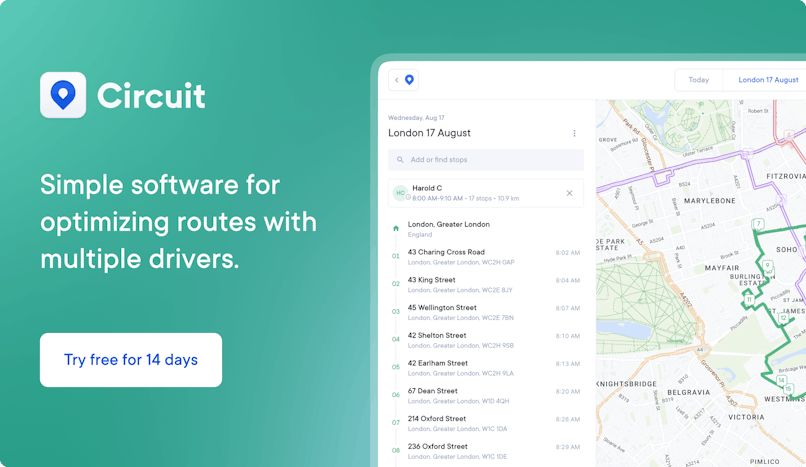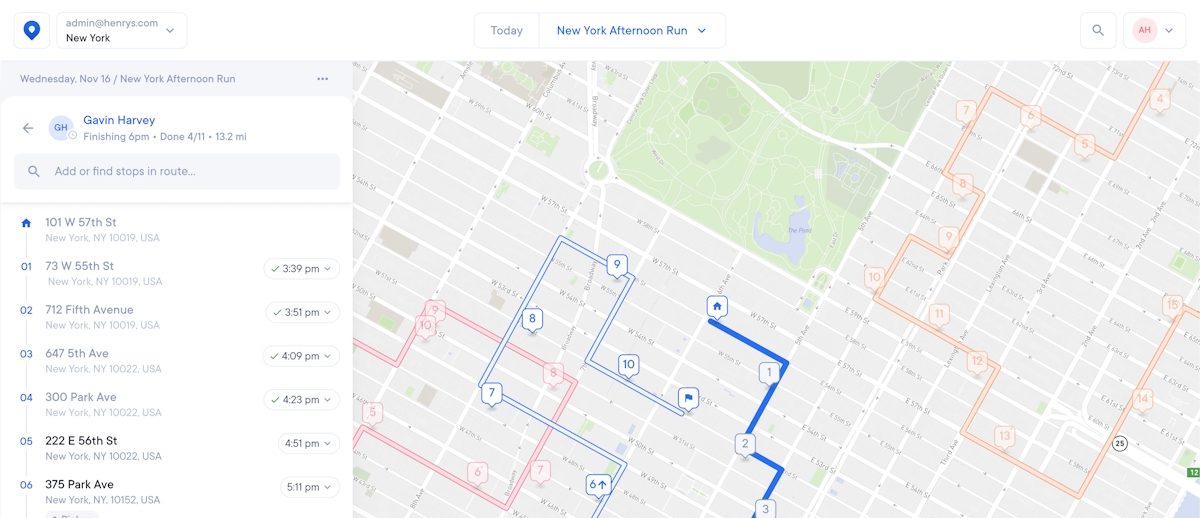Supply Chain Resilience: How To Build & Manage It
A resilient supply chain can help your business weather any storm. Learn how to build and manage a resilient supply chain here.

Circuit for Teams helps you adapt to unexpected delivery changes, building your supply chain resiliency.
When tough supply chain challenges arise, your supply chain’s resilience can determine your survival or failure.
Supply chain disruptions can come from natural disasters, supplier problems, or sudden market shifts. These disruptions can cause production delays, material shortages, higher costs, and strained customer relationships.
A survey of global supply chain leaders by McKinsey & Company shows that the COVID-19 pandemic “has forced many organizations to address vulnerabilities in their complex, highly globalized supply networks.”
A resilient supply chain is what sets successful companies apart during difficult times. It can help you adapt, bounce back, and keep your business running despite challenges, improving your customer satisfaction, profitability, and competitive advantage.
In this article, I’ll share practical strategies and best practices to build a resilient and adaptable supply chain that can weather any storm and maintain your business’s growth and success.
Key takeaways
- Enhance your supply chain resilience by strengthening your entire supply chain’s ability to withstand and adapt to disruptions, challenges, and uncertainties.
- Maintain extra inventory and production capacity as a safety net to handle unexpected increases in demand, supplier issues, or supply chain delays.
- Use advanced planning techniques like forecasting, scenario modeling, and risk management to optimize your resource allocation, streamline operations, and proactively address potential issues before they become problems.
- Diversify your supplier network and source raw materials or finished products from different places to minimize the impact of supplier problems or regional disruptions.

What is supply chain resilience?
Supply chain resilience is the ability of an end-to-end supply chain to withstand and adapt to disruptions, challenges, and uncertainties while maintaining its functionality and delivering value to customers.
You must have a solid plan to achieve supply chain sustainability.
This plan will help you navigate difficulties by implementing initiatives that balance short-term needs with long-term functionality. It will also help you with identifying potential risks and having redundancies and backup options so you’re ready to handle any surprises that come your way.
So, if you want to give your business an edge and be prepared for anything that comes your way, focus on building supply chain resilience.
What are the benefits of a resilient supply chain?
A resilient supply chain is a safety net that keeps your business afloat when challenges arise in your supply chain ecosystem.
A resilient supply chain allows you to:
- Be better prepared for surprises: It helps businesses deal with unexpected events like natural disasters, supplier issues, or sudden market changes.
- Keep customers happy: A resilient supply chain means products or services keep flowing smoothly during tough times, making customers happier and more satisfied.
- Save money: By being ready for disruptions, a resilient supply chain avoids costly delays and losses and saves a lot of money in the long run.
- Stay ahead of the competition: Companies with resilient supply chains can react faster to market changes and gain an advantage over their competitors.
- Build stronger supplier relationships: Working closely with suppliers and sharing information builds solid partnerships and helps everyone recover quickly from disruptions.
- Break down silos: Promoting cross-functional communication and aligning goals across your organization improves the flow of information and enhances overall resiliency.

How to build supply chain resilience
Building supply chain resilience is an ongoing journey that takes a comprehensive understanding of your end-to-end supply chain.
Efficient supply chain management allows you to optimize production, make better decisions, streamline supply chain operations, and adapt quickly to changes.
Here are ways to make your supply chain more resilient with supply chain planning:
Understand your value chain
A value chain is important in supply chain resiliency because it offers a comprehensive view of the end-to-end processes and activities involved in delivering a product or service. This allows you to:
- Identify areas for strengthening: Analyzing your value chain helps identify areas needing improvement (such as suppliers, logistics networks, production processes, and distribution channels) to enhance resilience.
- Diversify suppliers: The value chain perspective uncovers opportunities to diversify, have backup suppliers, and establish contingency plans to reduce vulnerability to disruptions.
- Respond quicker: Considering the value chain in supply chain resiliency planning lets companies improve their ability to anticipate and respond promptly to disruptions, minimizing their impact.
Understanding the value chain helps businesses identify critical dependencies, vulnerabilities, and potential points of failure within the supply chain.
Gather and leverage data
Gathering information from suppliers, customers, and your operations gives you valuable insights that help you make smart decisions and manage risks by:
- Understanding demand: Look at past sales, market trends, and customer behavior to predict demand accurately. This helps you plan production and manage inventory procurement so you have the right amount of stock.
- Tracking supplier performance: Monitor supplier data like delivery times and quality to spot any issues early on. This allows you to address problems quickly, build strong relationships with reliable suppliers, and keep your supply chain running smoothly.
- Spotting risks: Identify potential risks by analyzing data on things like weather conditions, politics, or the economy. This lets you prepare backup plans, diversify your sources, or find alternative routes to avoid disruptions.
Using data effectively helps you make informed decisions, improve your operations, and respond to any challenges that come your way.
Implement inventory and capacity buffers
Inventory and capacity buffers, like keeping safety stock and production capacity available, will help you to handle unexpected situations when:
- Managing demand changes: When demand suddenly increases or unforeseen issues arise, an inventory stockpile lets you meet customer needs without delays or lack of stock.
- Dealing with supplier problems: If a supplier faces difficulties like delays or quality issues, buffer inventory allows you to continue operations while the issue is resolved, preventing disruptions.
- Handling lead time variations: Suppliers can experience delays for various reasons. Buffer inventory helps bridge the gap during these delays for a continuous supply of materials or products.
- Coping with production disruptions: Unforeseen events like equipment breakdowns or natural disasters can interrupt production. Extra production capacity lets you adjust schedules and allocate resources to minimize the impact and keep things running smoothly.
Implementing inventory and capacity buffers gives you a cushion to absorb unexpected challenges, maintain a steady supply, and meet customer demands in uncertain circumstances.
Optimize production and supply chain planning
Using the following advanced planning techniques can help you improve supply chain efficiency and responsiveness.
- Efficient resource allocation: Advanced planning helps you allocate resources effectively. Accurately forecasting demand and planning capacity helps you make sure you have the right amount of materials, labor, and equipment to meet customer needs without waste or shortages.
- Scenario planning and risk assessment: Creating digital representations of the supply chain, or digital twins, lets you simulate scenarios to assess supply chain risks, identify vulnerabilities or disruptions, and test different strategies to optimize performance and improve decision-making.
- Streamlined logistics and transportation: Nearshoring and cross-docking can help you to optimize logistics and transportation operations. This means sourcing materials closer to home, planning the best routes, consolidating shipments, and reducing transit times, which saves time and money and promotes timely deliveries.
- Timely response to issues: Regularly monitoring and analyzing production and supply chain data lets you quickly identify any issues or bottlenecks. This allows you to address them promptly, preventing bigger problems that could disrupt your supply chain.
Optimizing production and supply chain planning allows you to make better decisions, streamline operations, and adapt to changes quickly, making your supply chain more resilient and efficient.

How to manage a resilient supply chain
As the business world keeps changing and challenges persist, prioritizing supply chain resilience is essential for success.
Apply the following tips to manage your supply chain and enhance resilience, reduce vulnerability to disruptions, and maintain the smooth flow of goods and services — even in challenging circumstances.
Maintain visibility
Maintaining visibility means having a clear understanding of your supply chain's activities, including suppliers and logistics providers, inventory, and logistics.
To maintain visibility, you can:
- Implement supply chain monitoring systems and supply chain technologies to track and capture real-time data
- Establish communication channels with suppliers and partners to exchange information on production, inventory levels, and potential disruptions
- Regularly analyze and assess data to identify bottlenecks, vulnerabilities, or areas that need improvement for proactive decision-making and risk mitigation
Maintaining visibility contributes to a resilient supply chain by allowing you to anticipate and respond effectively to disruptions, optimize operations, and minimize downtime.
Collaborate effectively
Effective collaboration involves building strong relationships and partnerships with suppliers, customers, and other supply chain stakeholders.
To foster collaboration, you can:
- Establish open lines of communication and encourage the sharing of information and ideas
- Engage in regular meetings or forums with key partners to discuss challenges, opportunities, and joint strategies
- Promote a collaborative culture within your organization, emphasizing teamwork, trust, and cooperation
Effective collaboration contributes to a resilient supply chain by enabling swift problem-solving, facilitating coordinated responses to disruptions, and promoting innovation and continuous improvement.
Foster data transparency
Data transparency means making relevant and accurate information available to all stakeholders in the supply chain network.
To foster data transparency, you can:
- Implement data management systems to collect, organize, and share data efficiently
- Define data-sharing protocols and standards to maintain consistency and reliability
- Establish secure platforms or portals for sharing data with suppliers, partners, and customers
Data transparency contributes to a resilient supply chain by enabling informed decision-making, facilitating collaboration, and enhancing trust among supply chain participants.
Avoid single-source supply chains
Avoiding single-source supply chains means diversifying your supplier base to reduce dependence on a single supplier.
To achieve this, you can:
- Identify alternative suppliers for critical components or services and establish relationships with them
- Conduct regular assessments of supplier capabilities, reliability, and financial stability
- Develop contingency plans and backup options for sourcing in case of supplier disruptions
Avoiding single-source supply chains contributes to a resilient supply chain by minimizing the impact of supplier failures, geopolitical risks, or market fluctuations.
Restructure when necessary
Restructuring when necessary means adapting and making strategic changes to your supply chain when faced with disruptions or changing market conditions.
To be adaptable, you can:
- Regularly assess the effectiveness and efficiency of your supply chain processes and structures
- Identify areas needing improvement or optimization and implement necessary changes
- Continuously monitor market trends, customer demands, and technological advancements to stay ahead of the curve
When necessary, restructuring contributes to a resilient supply chain by allowing for agility, responsiveness, and the ability to seize opportunities or mitigate risks effectively.
Investing in supply chain resiliency
Investing in supply chain resilience can protect your customer and help you stay competitive in the market.
Remember, building a resilient supply chain is an ongoing journey that takes continuous improvement, adaptability, and teamwork.
Be proactive, stay informed, and keep exploring new ways to boost your supply chain strategy.
Adapt to delivery changes quickly with Circuit for Teams
A resilient supply chain relies heavily on delivery performance, and that's where we come in. With Circuit for Teams, you can supercharge your delivery performance and boost efficiency, ultimately strengthening your supply chain's ability to bounce back from challenges.
Make quick decisions on the fly by managing routes in real time. Stay in sync with your drivers and dispatchers with instant updates, giving you the flexibility to reorganize deliveries on the spot for better outcomes.
Stay in the loop with delivery confirmations, geotags, and real-time stop status updates for smooth communication and operations. Ready to unlock the full potential of your supply chain? Give Circuit for Teams a try today!




